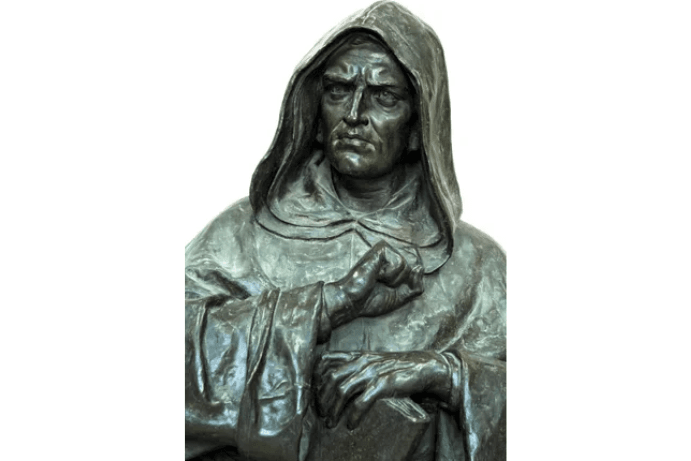On February 17, 1600, a brilliant yet controversial thinker met a tragic end at the stake, condemned by the Roman Inquisition for ideas that were centuries ahead of their time. But on this same date, years earlier, in 1548, a revolutionary mind was born — Giordano Bruno, an Italian Dominican friar, philosopher, mathematician, and astronomer. His fearless pursuit of knowledge and radical views on the universe set him apart.
While often overshadowed by the likes of Copernicus and Galileo, Bruno’s ideas were nothing short of revolutionary. He proposed an infinite universe filled with countless stars and planets, long before the concept of galaxies and exoplanets became common knowledge. He imagined a cosmos not confined to Earth’s dominion but one that stretched beyond human comprehension—a vision so bold that it ultimately led to his execution.
Today, Bruno is celebrated as a martyr for free thought and scientific inquiry, a man who stood by his convictions even in the face of the end. Let’s take a deep dive into the life, achievements, and enduring legacy of this extraordinary thinker.
A Mind Unchained: Bruno’s Early Years and Education
Born Filippo Bruno in Nola, near Naples, Giordano Bruno entered the Dominican Order at the tender age of 15. There, he adopted the name Giordano and immersed himself in theology, philosophy, and the works of ancient scholars like Aristotle and Thomas Aquinas. However, it wasn’t long before his intellectual curiosity clashed with the rigid doctrines of the Church.
Bruno’s refusal to conform became evident early on. He questioned traditional religious teachings and rejected the veneration of religious images. Bruno studied Copernican heliocentrism—the idea that the Earth orbits the Sun. By 1576, his unorthodox beliefs had made him a target, forcing him to flee his monastery and embark on a life of exile.
What followed was a restless journey across Europe—from Geneva to Paris, London to Wittenberg. There Bruno engaged with leading scholars, debated fiercely, and published groundbreaking works that blended philosophy, science, and mysticism.
Bruno’s Radical Ideas: A Universe Without Limits
One of Bruno’s most daring assertions was the concept of an infinite universe. At a time when most still believed in a finite, Earth-centered cosmos, Bruno argued that the universe had no center and edge. Also, he argued that the universe was filled with an infinite number of worlds—some potentially inhabited.
His ideas, inspired by Copernicus’s heliocentric model, took the radical leap that not only was the Sun just one of many stars, but other planets could host life. This was a direct challenge to both Aristotelian cosmology and the Church’s belief in Earth’s unique, divine status.
Bruno’s major works, including On the Infinite Universe and Worlds (1584), laid out these concepts in astonishing detail. His vision eerily foreshadowed modern astronomy and astrobiology, centuries before telescopes would confirm the existence of exoplanets orbiting distant stars.
But Giordano Bruno didn’t stop at science. He merged his cosmic ideas with Neoplatonism, Hermeticism, and mystical philosophy. He believed that understanding the universe was also a path to understanding God. To his supporters, he was a visionary; to his enemies, a dangerous heretic.
A Troublemaker in Every Court: Bruno’s European Exile
Bruno’s life was marked by constant movement. He lectured in Paris, debated in Oxford, and engaged with some of the brightest minds of his time. Yet, his sharp tongue and uncompromising stance often put him at odds with his hosts.
- He found patronage under Elizabeth I’s court in England but mocked Oxford scholars for their resistance to new ideas.
- Bruno continued teaching in Germany but clashed with Lutherans over religious doctrines
- In Venice, he hoped to find protection under a powerful nobleman but was betrayed and handed over to the Inquisition.
This final betrayal sealed his fate. Arrested in 1592, Giordano Bruno was extradited to Rome, where he faced years of imprisonment, interrogation, and mounting accusations of heresy.
The Trial and Execution: A Martyr for Free Thought
Bruno’s trial before the Roman Inquisition dragged on for seven years. His inquisitors demanded that he recant his views, but he refused. His charges included:
- Denying key Catholic doctrines like the Trinity and the virgin birth.
- Claiming the universe was infinite with multiple worlds.
- Practicing magical and occult teachings.
On February 17, 1600, Giordano Bruno was sentenced to end. Before his execution, he reportedly told his judges, “Perhaps you pronounce this sentence against me with greater fear than I receive it.”
Bruno was burned at the stake in Rome’s Campo de’ Fiori, refusing to renounce his ideas to the very end.
Bruno’s Legacy: The Philosopher Who Saw the Future
For centuries, Giordano Bruno was largely forgotten, overshadowed by Galileo, Kepler, and Newton. However, the 19th and 20th centuries saw a revival of interest in his work, recognizing him not only as a scientific pioneer but as a symbol of intellectual freedom.
His vision of an infinite cosmos aligns closely with modern discoveries in astronomy and astrophysics. While he lacked the observational tools to prove his theories, his intuition about an endless, evolving universe filled with countless worlds was astonishingly prescient.
Today, statues, books, films, and academic studies honor Bruno’s courage and ideas. The Campo de’ Fiori monument in Rome stands as a tribute to his defiance, and his name has been immortalized in space exploration, with NASA naming a crater on the Moon after him.

